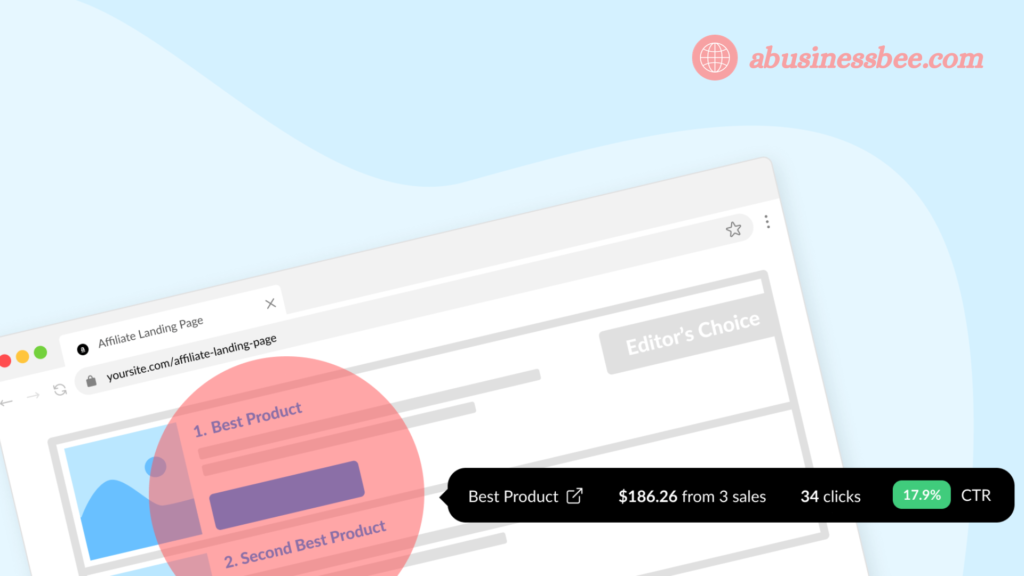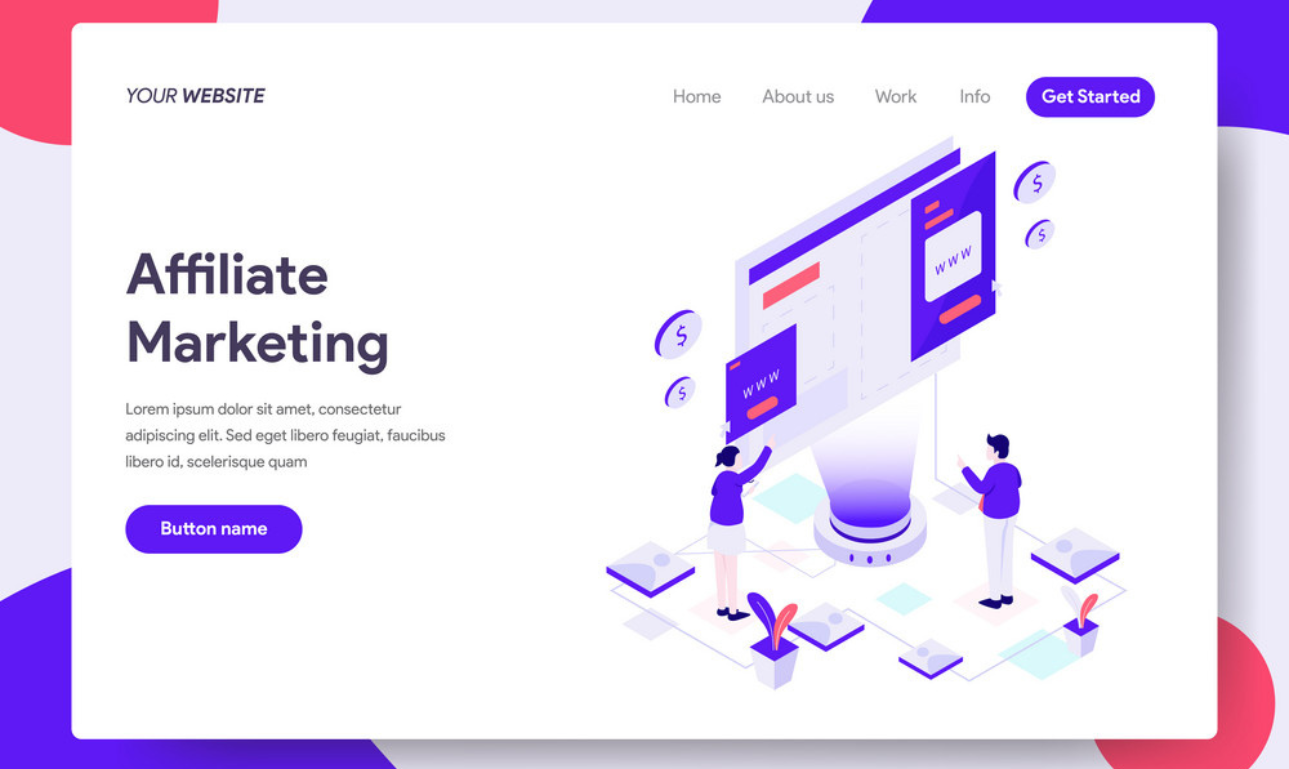This guide will cover essential points of How To Create Affiliate Marketing Landing Pages. Learn the tactics for the best landing page for affiliate marketing to get the best conversions.
How To Create A Free Landing Page For Affiliate Marketing?
A landing page is an important part of effective or successful affiliate marketing. The key to making the most out of affiliate marketing is a good landing page. It is your first impression with a potential client, but it’s also an important driver for conversions.
What is Affiliate Marketing?

Affiliate marketing is a strategy where people, known as affiliates, earn a commission by promoting and selling products or services from another company. In this process, every affiliate gets a unique link or code to track their referral sales.
Affiliate Marketing is now widely used because most of the businesses are online. It can help companies get more reach, and sell more services or products than usual businesses.
These days, more than 80 % of brands run their own affiliates’ programs. In the U.S., it is estimated that one-eighth to a third of sales are from affiliated merchants working for them.
So, it’s one of the best options for online advertising, up there with email marketing and paid search, both in terms of audience segmentation as well as social media. This is a win-win situation for sellers, affiliates, and customers.
What is an affiliate landing page?

An affiliate landing page is a specific web page designed to promote and drive conversions for affiliate products or services. The landing page can be considered a focused and final destination for visitors to learn about your affiliate product, service, or any offer.
The incoming traffic may originate from various sources such as social media, organic searches, email newsletters, or paid advertising. These landing pages can also play a role in a broader lead magnet or advertorial affiliate marketing funnel. The primary objective is to encourage potential customers to subscribe to email newsletters delivered in a drip format, gradually warming them up for high-value affiliate purchases.
The Landing page must be optimized and have relevant information about your service or product. It might look like a Seo-optimized blog post with compelling content, high-resolution visuals, and straightforward CTAs (Call to Action).
This discussion will primarily focus on the creation and optimization of landing pages by affiliate marketers.
How to Create Affiliate Marketing Landing Pages?
Before a high-converting affiliate landing page can effectively bring in leads for your affiliate marketing campaign or funnel, it’s crucial to ensure it’s set up correctly. Creating a landing page for affiliate marketing involves several key steps to ensure it effectively promotes affiliate products and encourages conversions. Here’s a step-by-step guide:
Select a Niche or Product:
You have to choose a niche, category for your affiliate marketing campaign. This helps in targeting a specific audience.
Identify high-quality affiliate products that align with your chosen niche. Consider products with good sales potential and favorable commission rates.
Choose a Platform:
You have to decide on one platform for creating your landing page. There are several options including website builders like WordPress, dedicated landing page tools, or even social media platforms.
Create a Dedicated Landing Page or Blog Post:
You have to develop a dedicated landing page with a clear Call to Action (CTA) and persuasive copy. Alternatively, you can create an SEO-optimized blog post specifically for your affiliate campaign.
If creating a blog post, optimize it for search engines by using relevant keywords. This can improve the visibility of your content in organic searches.
Compelling Headline and Hook:
For the best landing page, craft a catchy headline that grabs the reader’s attention and sparks curiosity, compelling them to delve further and lead to sales. Your words must motivate visitors to continue reading or scrolling, enticing them toward your Call to Action (CTA).
Your headline serves as the key element preventing visitors from immediately clicking away from your landing page. So, make sure this portion is good.
However, avoid creating a dull or overly sales-oriented heading. You have to take these points while writing the Headline of your landing page.
- Solve a problem
- Highlight a benefit
- Address a pain point
- Spark interest
Your headline should captivate your customers using vibrant language, showcasing something unique about the product or service you’re promoting, a compelling piece of data, or social proof.
Lastly, place a prominent and clear CTA on your landing page, encouraging visitors to click on your affiliate links or take the desired action, such as making a purchase.
Incorporate Visuals:
Use high-quality images, graphics, and videos to enhance the visual appeal of your landing page. Visuals can help showcase the product and capture attention.
Visual elements are not only engaging but also aid in conveying information more effectively than text alone, making them powerful tools for boosting conversions.
Here’s how you can utilize visuals effectively:
- Use infographics to illustrate the advantages of the promoted service or product.
- Showcase the affiliate product or service in practical use, helping visitors grasp its functionality.
- Highlight achievements or successes associated with the product through images accompanied by testimonials or statistics.
- Employ illustrations to guide how to utilize the promoted product effectively.
Ensure that your visuals don’t compromise page loading speed. Optimize by resizing and compressing images beforehand to reduce server space, resulting in faster loading times. This optimization maintains a balance between engaging visuals and efficient page performance.
Add Features and Benefits of your Product:
You have to add features and benefits of your product so people get knowledge about your product. Features are the technical functionalities of a product. Honestly, users don’t find this aspect all that captivating. Now, benefits, on the other hand, delve into how a product’s feature enhances the user’s life. And that’s precisely what your readers care about.
So, I suggest you write features with benefits. It will help to boost sales. But don’t overuse features and benefits. You can add social proofs instead.
Include Affiliate Links Naturally:
Integrate affiliate links seamlessly within your content. Avoid being overly promotional; instead, focus on providing value and information. Don’t add extra information or any other link to avoid diverting visitors’ focus.
Indeed, a HubSpot study found that eliminating links from landing pages resulted in increased conversion rates ranging from 2% to 28%, with middle-of-the-funnel (MOFU) landing pages experiencing the most substantial improvement.
If it’s a blog post, retaining navigation and internal links becomes essential to help visitors explore your site. These links also contribute positively to your website’s SEO. Naturally, it’s crucial to ensure that your affiliate links stand out, and you can achieve this by incorporating contrasting Call to Action (CTA) buttons.
Use the Power of Social Proof:

Now in the new era of marketing, everyone recognizes that post-modern consumers look more to reviews than brand advertising. This places customer testimony at the pinnacle of marketing assets.
testimonials are only one type of social proof that you can rely on to establish confidence in your readers. Demonstrate how other customers who have used it have done well.
An example is in the affiliate review below, where their Forbes Advisor rating acts as a kind of social proof–how many other people agree Squarespace makes for good website design. Such public endorsement encourages prospective purchasers to give the product a try.
While ratings play an important role in leveraging social proof on your landing page, there are additional effective methods you can employ:
Metrics and Statistics:
Metrics and statistics give your credibility a quantitative element. You could highlight key performance indicators or success rates that demonstrate the tangible impact of your service.
Video Testimonials from Successful Clients (Customer Success Stories):
Use video testimonials from your most productive clients to add flesh and blood to an affiliate product or service. These tales of customer success offer a human angle that potential customers can latch onto, making it apparent the gains to be had.
Before and After Photos:
Before-and-after photos can provide visual evidence to support your product or service’s ability to turn rags into riches. Illustrate the improvement in your customers ‘lives with pictures.
Case Studies Illustrating Impact:
Offer in-depth case studies of your affiliate product or service’s influence. Such details as to the customer experience and success or failure can be easily explained by recounting actual human stories.
Social Media Comments or Messages from Current Users:
Use social media comments or private messages from existing users to portray people interacting naturally, in the here and now. By showing actual users interacting with your product, this kind of social proof can provide another channel for establishing credibility.
If you only tell the readers about your product’s functions, it is insufficient. Prove its efficacy by using real-world success stories of those who have been there before it can work. Such various forms of social proof collectively strengthen your product’s credibility and appeal to customers.
Test and Track Performance:
Before launching online, it’s important to verify the functionality of your landing page. Conduct A/B testing on different elements of your landing page to optimize its effectiveness. This method involves creating two versions of your affiliate landing page, varying elements such as size, color, content placement, and CTAs.
Use analytics tools to track the performance of your page, including click-through rates and conversions. Moreover, make sure your landing page is mobile-friendly to accommodate users on various devices.
By following these steps, you can create a compelling landing page that effectively promotes affiliate products and maximizes your chances of success in affiliate marketing.
FAQs
Is a landing page good for affiliate marketing?
Yes, a landing page can be effective for affiliate marketing. A well-designed landing page helps to promote your products or services through visuals, calls to action, and compelling writing skills.
Can you do affiliate marketing without a landing page?
Yes, you can do affiliate marketing without a landing page. However, a landing page enhances your conversions as it contains compelling content and a call to action. Here are five methods to achieve this:
- Email newsletters
- Social media platforms
- Forums and online communities
- YouTube channel
- Free ebooks.
Does affiliate marketing pay daily?
No, affiliate marketing typically does not pay daily. Affiliate commissions are usually paid according to the terms set by the affiliate program, which could range from monthly to quarterly payments.
Final Thoughts:
To sum up this blog, success in affiliate marketing will depend on landing pages that combine persuasive copy with absorbing visuals and elements meant to build trust. If you do, I promise that your visitors will be most receptive to these details about affiliate marketing.
RELATED GUIDES:
